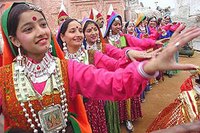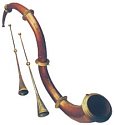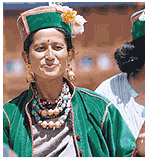
Most of the songs require no instrumental accompaniment. The themes are usually common ones like human love and separation of lovers. Some songs are about rituals. Chhinj, Laman, Jhoori, Gangi, Mohana and Tappe are love songs. Dholru is a seasonal song. Bare-Haren are ballads about warriors, Soohadiyan are songs sung at Childbirth. Losi and Pakkahad and Suhaag songs are all family songs, Karak are songs of praise in honour of the deities and Alhaini is a song of mourning. All these songs follow a specific style of singing and the geographical facts have a deep effect on these.
The songs are sung in unison and the singer decides how and which way the notes and syllables are to be pronounced. They make changes in lines and substitute or replace words.
Jhoori– The word means a lover or a beloved and is said to be connected with Jhoomar. Jhoomar is a female dance form. Both men and women sing and dance to Jhoori. It is a dance performed in the open and describes extra-marital love. It is very popular in Sirmaur and Mahasu areas and has a special rhythm of its own. Each piece has four lines and the last syllable in the first line is pronounced in a drawn-out fashion. The Jhoori songs place a great importance on the rhyming pattern within the song.
Laman- Laman singing is popular in the Kulu valley. These songs sing of the romantic love between men and women. The first line is only for rhyming with the second and it is the second line which furthers the theme. Syllables like Oa, Aa form the ‘Tek’ or the note which is prolonged at the end of the line. These syllables help the singers establish a certain resonance and a definite rhythmic pattern.The Samskara songs (sung at family festivals and other such occasions) are based upon classical Ragas. These songs are sung by women from the higher castes in the morning and at night time. Some of the morning songs have traces of Raga Asa in them. The songs sung at wedding are set in old Ragas like Durga, Malkauns and Bhoopali.The Jhanjhotis are based on Ragas like Bindrabani Sarang, Durga, Tilang and Des. The martial songs have combined traces of Asa and Durga. The Gidda songs are in Raga Durga. The songs sung by professional singers have very attractive classical overtones.
The famous love-lyrics in Himachal areas are Phulmu-Ranjhu, Kunju-Chanchalo and Raja-Gaddan. the Phulmu-Ranjhu lyric tells of a tragic episode. In Kunju-Chanchalo the song takes the form of a conversation between the lover and his sweetheart. The Raja-Gadden song records the wooing of gaddan Nokhu by Raja Sansar Chand of Kangra.
There are also songs which recall some important historical events like the sacrifice of Rani Suhi for a public cause, like bringing drinking water to Chamba town. The song called Sukrat is soulfully rendered and depicts the great story of the sacrifice of the Rani, famous for her feeling of love for the people and her deep human sympathy for them. Another tragic story telling the love of a brother who takes upon himself the blame for the murder his brother committed and thereby goes to the gallows in Bilaspur is depicted in one of the saddest song called Mohana.
Ceremonial lyrics such as Bhayi, Suhag, Suhagare and Vidayi are sung on special occasions like birth, betrothal and marriage. Seasonal song like Chhinj are sung only in Chaitra (March).
Ainchaliyan – Ainchali is a religious ballad. The customs of singing Ainchali in the house of the bride is common among the farming communities. In this the men-folk go to the houses of the married couples and sing these romantic Ainchali songs to the beat of drums or platters of pictures. The women sing these songs in the house of the unmarried girl. In these songs, incidents from the marriage of gods like Shiva and Rama are sung with great gusto.
In the Chamba-Pangi areas, the professional singers go from village to village with a khanjari (tambourine) and play on these as they sing. They also use string puppets. They sing traditional songs from Ramayana and Mahabharata. In the month of Chaitra, the Doms and Domanis go from house to house and sing Dholaru songs to the people.


Rana Singha, Shehnai and Been are usually played at wedding and on auspicious occasions. At the time of the ritual puja at the temples, Rana Singha, Karnal, Conch shells and Shehnai are played. These instruments accompany the processions of gods at festivals. In the Lahaul-Spiti areas in Granyang and Jumang and Mahasu some ancient musical instruments like Kindari can be heard.





thank you for nice himachli songs.
A.S.THAKUR BILASPUR
NICE PLACE NICE PEOPLE AND APNEE DAV BHUMMUI KO SALAM
Hi friends its Chewang here can anyone plz send me the lyrics of BASACHI AAYEE-O-TERI YAAD sung by Sher Singh
my mail id is [email protected]